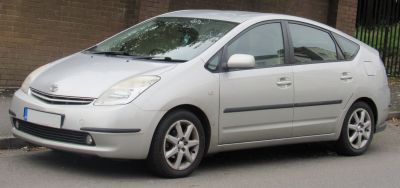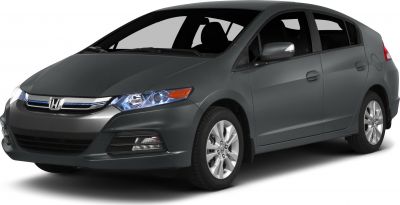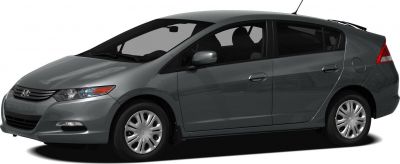 2010 Toyota Prius III (ZVW30) Dimensions, Size & Specs
2010 Toyota Prius III (ZVW30) Dimensions, Size & SpecsMeasurements of the 2010 Toyota Prius III, engineered for optimal performance and comfort
| Dimensions | |
|---|---|
| Length: | 4460-4480 mm175.6-176.4 in14.6-14.7 ft |
| Width: | 1745 mm68.7 in5.7 ft |
| Width (Opened Mirrors): | 2030 mm79.9 in6.7 ft |
| Height: | 1490 mm58.7 in4.9 ft |
| Trunk Capacity: | 443-445 liter15.6-15.7 cu ft |
| Trunk Capacity (Max): | 1543-1545 liter54.5-54.6 cu ft |
| Weight Specifications | |
| Curb Weight: | 1370-1425 kg3020-3142 lbs |
| Maximal permitted Weight: | 1805-1840 kg3979-4057 lbs |
| Roof Load: | 75 kg165 lbs |
| Tire Specifications | |
| Rims Sizes: | 15-inch rims:
|
| Tire Sizes: |
|
The Toyota Prius III (ZVW30), produced from 2009 to 2015, represents the third generation of Toyota's pioneering hybrid hatchback, offering improved fuel efficiency, comfort, and practicality. This 2010 model year hatchback has a length ranging from 4460 to 4480 millimeters (175.6 to 176.4 inches), a width of 1745 millimeters (68.7 inches), which extends to 2030 millimeters (79.9 inches) including opened mirrors, and stands 1490 millimeters tall (58.7 inches). The vehicle's curb weight varies between 1370 to 1425 kilograms (3020 to 3140 pounds), with a maximum permissible weight between 1805 and 1840 kilograms (3979 to 4058 pounds), making it relatively lightweight for its category, contributing to fuel economy and agile driving dynamics.
The Prius III's luggage capacity is generous for a compact hatchback, offering between 443 to 445 liters (15.6 to 15.7 cubic feet) with rear seats in place. When the rear seats are folded flat, the storage volume dramatically increases to between 1543 and 1545 liters (54.5 to 54.6 cubic feet), enhancing versatility for larger cargo. Roof load capacity is limited to 75 kilograms (165 pounds), suitable for roof racks or light cargo carriers.
It rides on rims sized between 6J x 15 inches and 7J x 17 inches, paired with tire sizes of 195/65 R15 and 215/45 R17, balancing comfort with efficient road grip. Overall, the Toyota Prius III (ZVW30) offers a practical, well-sized hatchback hidden under a sleek, aerodynamic design that appeals to eco-conscious drivers needing space without sacrificing compactness.
Discover the standout features that make the 2010 Toyota Prius III a leader in its class
Have a question? Please check our knowledgebase first.
The Toyota Prius III (ZVW30), produced from 2009 to 2015, has a length that varies slightly between approximately 4460 mm to 4480 mm (175.6 to 176.4 inches). Its width is 1745 mm (68.7 inches) without mirrors, expanding to 2030 mm (79.9 inches) when the mirrors are open. The height stands at 1490 mm (58.7 inches). These dimensions place the Prius III firmly within the compact hatchback category, balancing aerodynamic efficiency with practical interior space.
The Prius III (ZVW30) has a curb weight ranging between 1370 kg and 1425 kg (approximately 3,020 to 3,141 pounds), depending on specific trim and equipment. The maximum permissible weight, often referred to as gross vehicle weight rating (GVWR), is between 1805 kg and 1840 kg (roughly 3,980 to 4,056 pounds). This weight range reflects the vehicle's efficient hybrid system and construction that balances durability with fuel economy.
The luggage capacity of the Prius III is quite practical for a compact hatchback. With the rear seats up, it offers between 443 and 445 liters (approximately 15.6 to 15.7 cubic feet) of cargo space. When the rear seats are folded down, this expands significantly to between 1543 and 1545 liters (around 54.5 to 54.6 cubic feet), allowing for much larger items and versatile cargo configurations. This flexibility makes the Prius III suitable for both daily commuting and occasional larger load requirements.
Yes, the Toyota Prius III fits comfortably into a standard garage. With a maximum length of about 4480 mm (176.4 inches) and a width of 1745 mm (68.7 inches) excluding mirrors, the vehicle is compact enough for typical residential garages. Even with the side mirrors open, at 2030 mm (79.9 inches), it still fits within many garage widths, although it may be tight in some narrower garages. Its height of 1490 mm (58.7 inches) poses no clearance issues for standard garage door heights.
The Toyota Prius III's width is 1745 mm (68.7 inches) without the mirrors, but it increases significantly when the mirrors are opened. The total width with mirrors extended is 2030 mm (79.9 inches), which is an increase of about 285 mm (11.2 inches). This difference is important to note for maneuvering through tight spaces and parking, as the open mirrors require extra clearance.
The Prius III comes equipped with a variety of rim and tire size options tailored to different trims and preferences. Rim sizes available include 6J x 15 inches and 7J x 17 inches. Corresponding tire sizes are 195/65 R15 and 215/45 R17. These sizes offer a balance between ride comfort, handling performance, and fuel efficiency. The smaller 15-inch rims with higher profile tires generally provide a softer ride and better fuel economy, while the larger 17-inch rims with lower profile tires improve handling and aesthetics.
The Prius III has a height of 1490 mm (58.7 inches), which gives it a low profile conducive to reduced air resistance and better fuel efficiency. This height also ensures ease of entry and exit for most passengers, while fitting well in covered parking spaces. The roof load capacity is rated at 75 kg (about 165 lbs), meaning the vehicle can safely carry roof-mounted cargo like bike racks or small roof boxes, adding versatility for active lifestyles or trips requiring additional storage.
Compared to its predecessor, the Prius II (XW20), the Prius III (ZVW30) has undergone a redesign that affected dimensions and weight. The Prius III is slightly longer at around 4460 to 4480 mm (175.6-176.4 inches) compared to the Prius II’s length of approximately 4465 mm (175.9 inches), with a marginal increase in width and a slightly lower height, enhancing aerodynamic performance. In terms of weight, the Prius III tends to be heavier, generally ranging from 1370 to 1425 kg (3,020 to 3,141 lbs), versus the Prius II's curb weight of around 1310 to 1370 kg (2,889 to 3,020 lbs), reflecting additional safety features and updated hybrid technology.
When comparing the Prius III to similar hybrid hatchbacks such as the Honda Insight and Ford C-Max, the Prius is generally competitive in size. The Prius III’s length runs from 4460 mm to 4480 mm (175.6 to 176.4 inches), which is comparable to the Honda Insight's length of approximately 4540 mm (178.7 inches) and the Ford C-Max’s length near 4410 mm (173.6 inches). The Prius’s width at 1745 mm (68.7 inches) falls in a similar range, though the Ford C-Max is typically wider. The luggage capacities also show the Prius’s advantage, especially with rear seats folded, thanks to its hatchback design, a feature shared with these competitors which provides versatile cargo space for family or lifestyle needs.
Potential buyers should appreciate that the Prius III’s compact dimensions and relatively lightweight design contribute to excellent fuel efficiency and ease of urban maneuverability. Its moderate length (4460-4480 mm or 175.6-176.4 inches) and width (1745 mm or 68.7 inches) keep it agile in traffic and convenient to park, while the generous interior space and cargo volume—443-445 liters with seats up and over 1500 liters with them folded—ensure practical daily usability. However, due to its width with mirrors open (2030 mm / 79.9 inches), owners should be mindful when navigating narrow gateways or tight parking spots. The roof load of 75 kg adds useful versatility. Altogether, these dimensions make the Prius III well suited for city dwellers and eco-conscious drivers needing both efficiency and functionality.
Discover similar sized cars.

| Production: | 2017-2025 |
|---|---|
| Model Year: | 2018 |
| Length: | 4490 mm176.8 in |
| Width: | 2030 mm79.9 in |
| Height: | 1530-1540 mm60.2-60.6 in |

| Production: | 2003-2009 |
|---|---|
| Model Year: | 2004 |
| Length: | 4450 mm175.2 in |
| Width: | 2015 mm79.3 in |
| Height: | 1490 mm58.7 in |

| Production: | 2001-2004 |
|---|---|
| Model Year: | 2001 |
| Length: | 4385 mm172.6 in |
| Width: | 1720 mm67.7 in |
| Height: | 1430-1444 mm56.3-56.9 in |

| Production: | 2012-2014 |
|---|---|
| Model Year: | 2012 |
| Length: | 4395 mm173.0 in |
| Width: | 1695 mm66.7 in |
| Height: | 1425-1435 mm56.1-56.5 in |

| Production: | 2009-2011 |
|---|---|
| Model Year: | 2010 |
| Length: | 4396 mm173.1 in |
| Width: | 1695 mm66.7 in |
| Height: | 1425 mm56.1 in |
